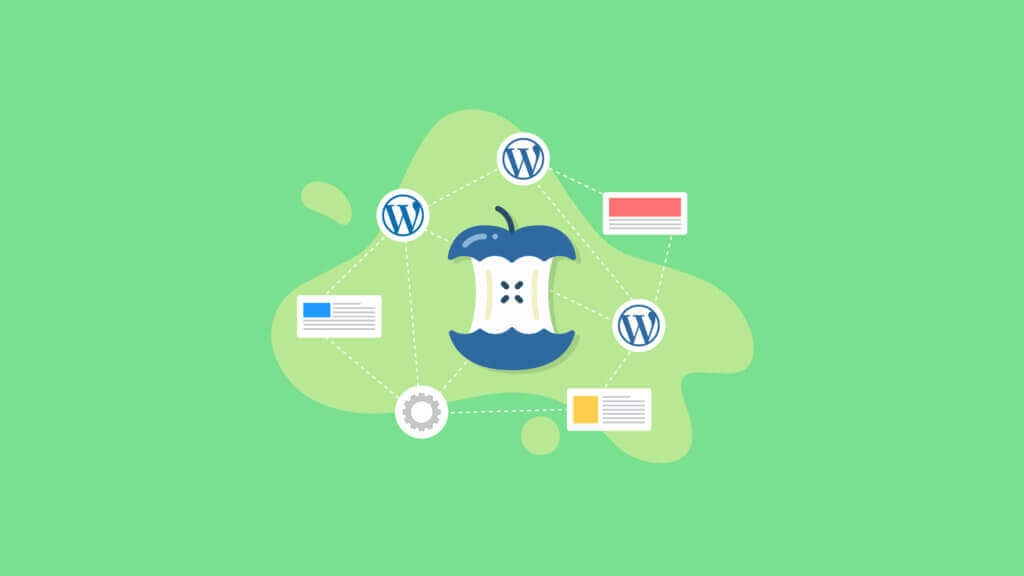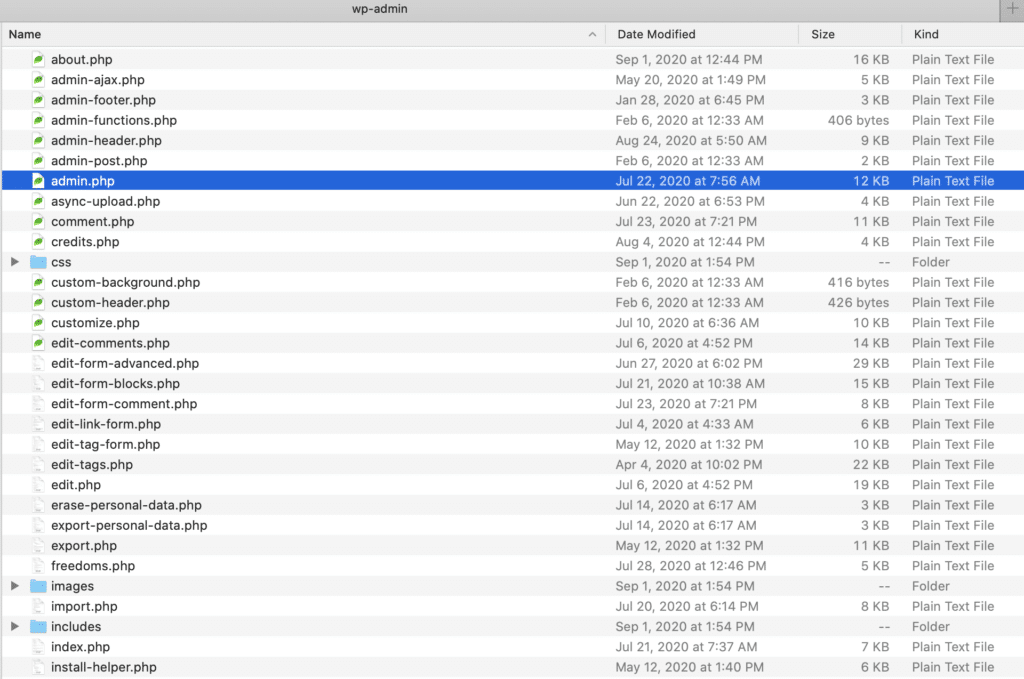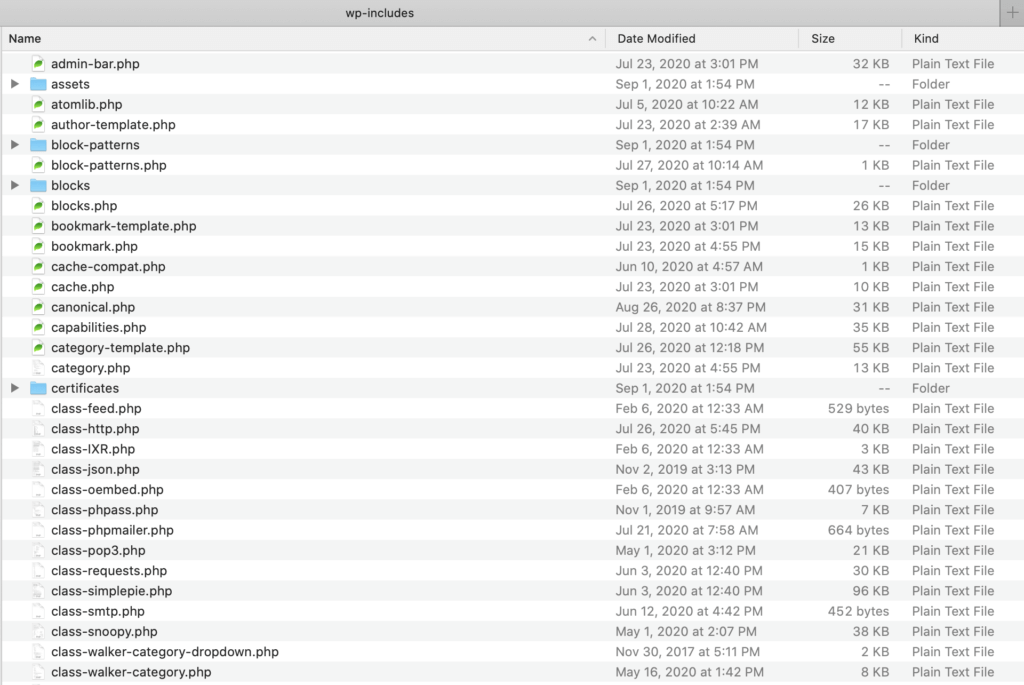The term "WordPress Core" encompasses all the core files that a WordPress website needs to function. In this article, we will take a detailed look at the core of WordPress. By the end, you'll know exactly what WordPress Core means, what it does, how you can contribute to WordPress, and more. If you're ready, let's get started.
As you are probably already aware, WordPress as a content management system is easy to use and understandable. Almost anyone with a basic knowledge of websites can design and run a successful WordPress site. What makes WordPress so popular is that you can do this without needing to know what's going on behind the scenes.
But at some point, you will probably want to have more information about the underlying files that run your website. Knowing what's going on underneath your WordPress website allows you to take actions like troubleshooting errors and issues beyond what you can do in the WordPress admin dashboard.
WordPress Core files, where to find them, and what each one does, you'll open up a world of development opportunities for your site. You'll also learn how to quickly troubleshoot your own site issues and eventually be able to install a few custom features like a pro.
The Four Parts of a WordPress Website
Before we go deeper, let's cover some basics. Every website running on WordPress consists of four different parts.
Understanding these four components of all WordPress websites is important if you want to work successfully with WordPress:
- WordPress Core files
- WordPress database
- Theme files
- Plugin files
What is WordPress Core?
WordPress Core, It is a way of referring to all the "core" files required for WordPress to work. WordPress Core, in the form of a zip file From WordPress.org/download is what you downloaded. WordPress Coreis a way of referring to all the "core" files required for WordPress to work.
Core files allow you to do things like the following:
- Access the WordPress admin dashboard
- Add and edit posts and pages
- Manage Users
- Upload media files
- Delete content
- Add tags and categories
- Embed videos
- Allow users to respond and comment
- ... And much more
WordPress CoreIf you want to see exactly what it is, all you need to do is remove all themes and plugins from your WordPress dashboard. That way you'll only have WordPress Core will remain.
Only on your website WordPress Core remains, the first thing you'll notice is that you won't be able to build or view your website with only the basic files installed.
So when you first install WordPress, you'll notice that it includes a few generic themes that you can automatically start working with to make your site visible. But the standard themes included in a WordPress installation are not technically part of the core.
Without the help of a theme or plugin, the core of WordPress performs all these functions on its own. However, it can't do everything you need to do to build your website. Beyond the WordPress core, you need themes and plugins to build your website. WordPress plugins you'll need.

WordPress Core Files
Two of the most important core WordPress files include the following:
- wp-config.php - This file controls all the basic settings of your WordPress website, including your database connection information.
- functions.php - This file is one of the most important operating files of WordPress. Important note: Your theme has a functions.php file and this is the file you need to edit, not the core file located in the base directory of your website.
There are many other files that are crucial to the way your site works. For practicality, most of your troubleshooting time (if any) should be spent on .htaccess and wp-config.php will be spent on their files.
The WordPress core also has two important folders:
- wp-content - This folder contains your plugins, themes and media uploads.
- wp-admin - This folder contains all the files that power the WordPress admin dashboard.
Don't worry if these names sound like Greek to you right now. We will discuss each one in a little more detail. 🙂
If you go on to edit core files in WordPress, always avoid changing any code unless you fully understand exactly what you are doing. Before making any changes to the WordPress core files, make sure to take a backup of your website with the WordPress backup plugin.
A Look Inside the WordPress Core Zip File
To take a look inside the WordPress core file, simply extract the contents of the zip file on your computer. When you extract the WordPress zip file you downloaded earlier from WordPress.org, you will see the following list of files:

These important WordPress core files are included with every WordPress installation and are located in the main (parent) directory once installed on your server.
How to Access Your Website's WordPress Core Files
To access the underlying WordPress files in your website's backend, FileZilla you need to download and install an sFTP client (it is completely free and works perfectly on all operating systems). This will allow you to access WordPress files directly.
You will then need to connect to your website's server via the FTP client with the credentials given to you by your website host. If you are not familiar with what your credentials are, check with your hosting provider.
You can also use the File Manager provided by your WordPress server. The most common file manager platform is cPanel.
Wp-config.php File
The wp-config.php file provides basic configuration details for the WordPress website.
The wp-config.php file contains information necessary for your WordPress website to function, including MySQL database connection settings, WordPress salts and keys, WordPress database table prefix, WordPress language, and ABSPATH (absolute path to the WordPress directory).
Functions.php File
WordPress functions.php is an extremely important WordPress Core file located in the wp-includes directory.
In addition, the theme you choose for your site also has a functions.php file. This file allows you to add features and functions to your website that depend on your theme.
It is important to note that your theme's function.php file works regardless of its name in /wp-includes. The functions applied to the functions.php file in your theme's file structure will only live while you are using that theme.
Think of Functions.php as a plugin that you can download and install on your website. With the Functions.php file, you can add customized functions (makes sense, right?) to your website by developing your own. Of course, you will need to understand PHP first. You can also use this file to call predefined functions that you want to implement on your site.
WordPress wp-admin Folder
Most of the files that power the WordPress dashboard are located in the wp-admin folder. The files inside the wp-admin folder spawn a different file for almost every core WordPress feature.

Admin.php
The file we are currently interested in is admin.php. This is the file located at the very root of your /wp-admin folder. It works to enable a large number of your website's most important features, including the following:
- Installing the WordPress dashboard
- Connection to your database
Also, the admin.php file checks user credentials and applies permissions accordingly.
Some other important core files in the directory include:
- users.php
- update.php
- network.php
WordPress wp-content Folder
The wp-content folder contains mostly plugin and theme files related to your site. It doesn't host anything directly connected to WordPress Core. Therefore, we will focus on the wp-include folder in this article.

WordPress wp-include Folder
Think of your wp-include folder as the folder that stores the "rest" of the files that power your WordPress site. In other words, since wp-admin works to manage your administration tools, the wp-include folder is the file that makes everything possible.

When you open the wp-include directory, you will immediately notice how big it is. In fact, there are more than 100 individual files at the top level of the folder. Obviously, we can't cover every single one of them here.
As you become more familiar with WordPress core files, where to find them, and what each one does, you'll open up a new world of development opportunities for your site. You'll also learn how to quickly troubleshoot your own site issues and eventually be able to install a few custom features like a pro.
Included in WordPress Core Non-existent Components of a WordPress Website
Now that we've covered WordPress core files, let's look at what's not included in WordPress core files.
- WordPress database - The WordPress database stores most of the content of your WordPress site.
- .Htaccess This file is usually hidden so you need to enable the Hidden File option to access it - show it. Note that some hosts no longer support this file.
- WordPress theme files - Your WordPress theme files are separate from the WordPress core.
- WordPress plugin files - WordPress plugin files are also separate from the core.
WordPress Database
WordPress databaseis the foundation of the WordPress website, but is separate from the WordPress core files. To install WordPress, you need to set up a database on your server (usually through your WordPress server).
Without a database, your WordPress website cannot function. The WordPress database provides the power to load and run your website, it also stores and saves the content of your blog, such as posts and comments, and any changes you (or even your visitors) make. Essentially, a WordPress website is "a pretty face in a database".
A WordPress database is a MySQL database that stores your website's data in tables, rows and columns. The WordPress database is dynamic, meaning you can add, modify and delete the information it contains (provided you have administrative access).
Generally speaking, every WordPress site is made up of many different types of data. All this data needs to be stored somewhere. WordPress database this is where it comes into play.
The concept of a database is not unique to the WordPress platform. A database can be simple or complex. It can be small or large. But what all databases have in common is that they store information in a fast and easy-to-access way.
Some examples of the different types of data stored in the WordPress database include the following:
- Pages, posts and additional content
- Tags, categories and other organizational information
- User reviews and profile data
- Theme and plugin related data
- Full site settings
It's easy to see that almost everything that makes up your website is stored in the WordPress database. This alone is a good reason to learn more about how the WordPress database works.
.Htaccess File
.htaccess stands for "hypertext access". This file also controls the structure of your permalinks. This is a file you will probably access quite often, so it is very important to familiarize yourself with it.
Note that not all hosts support the .htaccess file.
WordPress Themes
There are literally thousands of free and premium themes available for download from the WordPress repository and independent sites on the internet. The primary (but not only) purpose of a WordPress theme is to set the overall style and design of your website or blog.
Each theme has specific instructions built into its code that set the parameters for how your website will look, including basic design variables such as
- Site layout
- Background color
- Size of images
- Font size, color, weight and style
These variables help define your theme and the aesthetics of your website. But that's not where the theme you choose stops working for you. Many more theme-specific features can be built into themes, such as how you build your homepage, how your site interacts with social media, and site e-commerce functionality.
WordPress Plugins
Think of WordPress plugins like apps on your smartphone. A WordPress plugin is a software program that you download and install on your WordPress dashboard that adds to the default functionality of WordPress.
Currently, there are more than 60,000 plugins reported in the WordPress repository and on other plugin developer sites. WordPress plugin are available.
In reality, there are probably more than 60,000 plugins on the market. This number reflects the plugins that are currently being updated by their developers to the current version of the WordPress core (version 5.4.1).
Note, however, that not every plugin available performs a unique function. Add-ons the vast majority have competitors with plugins that perform similar functions in different ways.
Plugins Are Sometimes Part of the WordPress Core
The interesting thing about plugins is that every once in a while a plugin gains a huge amount of popularity and gets millions of installs from WordPress developers. When this happens, there is usually a push to include this plugin as part of a standard WordPress installation.
What this actually means is that the plugin will be part of the core of WordPress. And that's exactly how the core evolves.
The Gutenberg block editor is a good example. When the Gutenberg block editor was introduced as a standalone plugin to version 5.0 of WordPress, it quickly became extremely popular as a new way for WordPress developers to build their pages and posts.
Due to the overwhelming popularity of the plugin, WordPress decided to add the Gutenberg blocks functionality directly into the WordPress core in version release 5.0.



